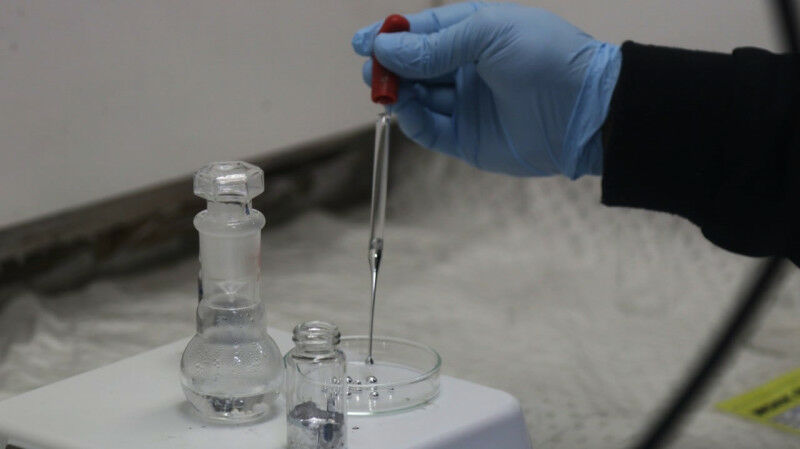博文
液态金属撼动了百年化工工艺
||
液态金属撼动了百年化工工艺
诸平
Fig. 3 Liquid gallium at the School of Chemical and Biomolecular Engineering
据澳大利亚悉尼大学(University of Sydney)2023年11月10日提供的消息,为化学工业提供了改变未来化学过程的无与伦比的可能性(Liquid metals shake up century-old chemical engineering processes)。研究人员对一项新技术进行了测试,他们希望这项新技术可以取代20世纪初的能源密集型化工过程,液态金属可能是人们期待已久的“绿色”化工解决方案。相关研究结果于2023年11月9日在《自然·纳米技术》(Nature Nanotechnology)网站发表——Junma Tang, Andrew J. Christofferson, Jing Sun, Qingfeng Zhai, Priyank V. Kumar, Jodie A. Yuwono, Mohammad Tajik, Nastaran Meftahi, Jianbo Tang, Liming Dai, Guangzhao Mao, Salvy P. Russo, Richard B. Kaner, Md. Arifur Rahim, Kourosh Kalantar-Zadeh. Dynamic configurations of metallic atoms in the liquid state for selective propylene synthesis. Nature Nanotechnology, 2023. DOI: 10.1038/s41565-023-01540-x. Published: 09 November 2023. https://www.nature.com/articles/s41565-023-01540-x
参与此项研究的有来自澳大利亚悉尼大学(The University of Sydney, Sydney, New South Wales, Australia)、澳大利亚新南威尔士大学(University of New South Wales简称UNSW, Sydney, New South Wales, Australia)、澳大利亚皇家墨尔本理工大学(RMIT University, Melbourne, Victoria, Australia)、澳大利亚阿德莱德大学(The University of Adelaide, Adelaide, South Australia, Australia)以及美国加州大学洛杉矶分校(University of California, Los Angeles, CA, USA)的研究人员。上述图1(Fig. 1)是通过注射器将镓液态金属放入培养皿中。
化工生产约占温室气体排放总量的10%- 15%。世界总能源的10%以上也用于化工厂。
发表在《自然·纳米技术》网站的研究结果提供了一种急需的创新,摆脱了由固体材料制成的旧的、能源密集型催化剂。该研究由悉尼大学化学与生物分子工程学院(University of Sydney’s School of Chemical and Biomolecular Engineering)院长库洛什·卡兰塔-扎德教授(Professor Kourosh Kalantar-Zadeh)以及悉尼大学和新南威尔士大学(UNSW)联合工作的唐俊马(Junma Tang音译)博士领导。
催化剂是一种在不参与反应的情况下使化学反应更快、更容易发生的物质。固体催化剂,通常是固体金属或固体金属化合物,通常用于化学工业中制造塑料、化肥、燃料和原料。然而,使用固体工艺的化学生产是能源密集型的,需要高达1000 ℃的温度。
新工艺改为使用液态金属,在这种情况下溶解锡和镍,这赋予它们独特的流动性,使它们能够迁移到液态金属的表面并与输入分子(例如菜籽油)发生反应。这导致菜籽油(canola oil)分子旋转、破碎和重新组装成更小的有机链,包括丙烯(propylene),一种对许多行业至关重要的高能燃料。
库洛什·卡兰塔-扎德教授表示:“我们的方法为化学工业降低能耗和绿色化学反应提供了无与伦比的可能性。预计到2050年,化学行业的温室气体排放量将占总排放量的20%以上。但化学制造比其他行业更不引人注目——范式转变至关重要。”
该流程如何运作(How the process works)
液态金属中的原子比固体中的原子排列更加随机,并且具有更大的运动自由度。这使得它们很容易接触并参与化学反应。库洛什·卡兰塔-扎德教授说:“理论上,它们可以在更低的温度下催化化学物质,这意味着它们需要的能量少得多。”
化学与生物分子工程学院液态镓(Liquid gallium at the School of Chemical and Biomolecular Engineering)
在他们的研究中,作者将高熔点镍和锡溶解在熔点仅为 30 ℃的镓基液态金属中。
“通过将镍溶解在液态镓中,我们在非常低的温度下获得了液态镍——充当‘超级’催化剂。相比之下,固态镍的熔点为 1455 ℃。液态镓中的锡金属也经历过同样的效果,但程度较轻,”唐博士说。
本研究得到了澳大利亚研究委员会(Australian Research Council简称ARC)获奖者奖学金{ Australian Research Council (ARC) Laureate Fellowship grant (FL180100053)}的支持。
上述介绍,仅供参考。欲了解更多信息,敬请注意浏览原文或者相关报道。
The use of liquid gallium as a solvent for catalytic reactions has enabled access to well-dispersed metal atoms configurations, leading to unique catalytic phenomena, including activation of neighbouring liquid atoms and mobility-induced activity enhancement. To gain mechanistic insights into liquid metal catalysts, here we introduce a GaSn0.029Ni0.023 liquid alloy for selective propylene synthesis from decane. Owing to their mobility, dispersed atoms in a Ga matrix generate configurations where interfacial Sn and Ni atoms allow for critical alignments of reactants and intermediates. Computational modelling, corroborated by experimental analyses, suggests a particular reaction mechanism by which Sn protrudes from the interface and an adjacent Ni, below the interfacial layer, aligns precisely with a decane molecule, facilitating propylene production. We then apply this reaction pathway to canola oil, attaining a propylene selectivity of ~94.5%. Our results offer a mechanistic interpretation of liquid metal catalysts with an eye to potential practical applications of this technology.
https://blog.sciencenet.cn/blog-212210-1409212.html
上一篇:扩大纳米规模以实现可持续制造
下一篇:研究利用手性声子转化量子效应


